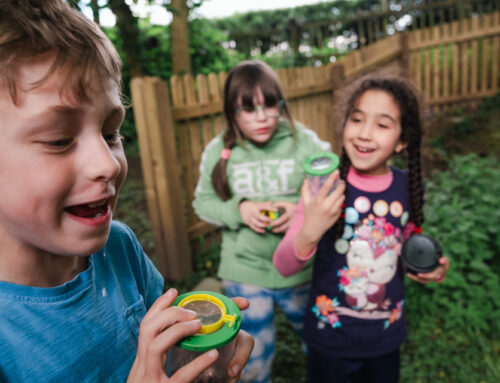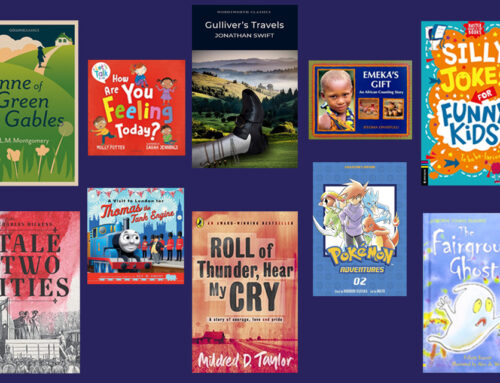If you enjoyed last month’s article on challenging students in remote learning, we have 5 more ideas below for you to share with teachers across your school. We’d love to hear how you have been challenging your learners in remote and blended learning. If you’d like to share your ideas with other schools, get in touch through focus@potentialplusuk.org
- What If…?
What if…? questions are great to challenge students’ perceptions and get them thinking outside the box. They can be as wacky and off-topic as you like, but equally can be used as extension questions or part of a topic. In live remote learning environments, you can use a What if…? question as a starter to get brains going or to recap on the previous lesson. You could also prepare a What if…? on a slide to use when appropriate, pop it in the chat or send only to particular students or fast-finishers.
Here are some off-topic examples:
- What if computers took over the world?
- What if plastics were banned?
- What if there was no electricity anywhere in the world for a year?
- What if we could switch places with our pets?
- What if we had to use every moment of our lives productively?
And here are some subject-based examples:
- What if fire didn’t need oxygen?
- What if we experienced only one emotion at once?
- What if our town had double the population?
- What if Henry VIII had had only one wife?
- What if we had proportional representation?
- What if there was no gravity?
- What if only renewable energy were allowed?
What if….? questions encourage divergent thinking and discussion can be generated. Once the question has been asked, students can submit answers via chat, write a short amount of text to show the class or a group using Padlet, PowerPoint or similar, or discuss in small groups. You can ask further questions for clarification, to recall additional facts and to prompt deeper thinking. You could ask another student to respond to an answer given or to give another, different perspective. Modelling this for students means that on another occasion they could challenge each other in groups or pairs in the same way.
- Investigate!
Many schools have found that asynchronous online learning works well for factual learning but doesn’t work so well for taking the learning further and thinking more deeply. For this, discussion and group activities are often needed.
Investigate! allows students to work autonomously to further their own learning. Investigate! is essentially self-directed learning where students have a choice of what to learn. This works best towards the end of a topic, although can be used earlier for those who learn factual information very quickly.
Students are given a task to learn about an aspect of the topic that they want to find out more about. This can be done with parameters, so that students have several choices, or students can submit for approval what they want to learn about. It works best when a higher-order question is asked as the learning objective, so some time should be spent getting this right at the start. There should be an outcome in the form of written work, PowerPoint presentation, poster, video or voice recording that is submitted by a deadline.
Examples of Investigate! tasks:
- (Time) Make a presentation for the class on what time of day it is in a different part of the world of your choice.
- (Predators) Create a short PowerPoint to present to the class about a predator of your choice.
- (Mayans) Using KWL questions, research an area of the Mayans you would like to know more about and create something to show your findings that can be put in a digital resource for parents.
- (Hiroshima) What can you find out about any of the survivors of the Hiroshima attack? Create a piece of writing to demonstrate your research that will be part of a class resource.
- What is the Question?
This activity involves giving students a prompt in the form of an answer and asking what the question could be. Students’ responses give you a good measure of what level children are thinking at and, similarly to What if…? questions, the activity encourages divergent thought. What is the question? can be used as warm-ups and engaging activities on a PowerPoint at the start of a live lesson, perhaps to partially recap some of the learning in the last lesson, or as an active learning activity part way through. Alternatively, a prepared ‘answer’ could be given to fast-finishers with as many ‘questions’ as the student can generate being the task. Additional credit could be given for the diversity of ‘questions’.
Examples of what is the question? activities
- The answer is 99. What is the question?
- The answer is water. What is the question?
- The answer is William Morris. What is the question?
- The answer is nuts. What is the question?
- The answer is Machu Pichu. What is the question?
- The answer is the North Pole. What is the question?
- The answer is Romeo. What is the question?
- The answer is meander. What is the question?
- Give a Role
A great way of challenging students is to ask questions and set activities that put them in an imaginary role. For example, when learning about nutrition, ask students to think of advice they would give as a dietician to a parent of a child their age or to a teenager. This kind of activity can adapt to many different subject scenarios and form a fundamental activity in the lesson, bringing together the learning so that there is a conceptual understanding.
Here are some subject examples:
RE: attitudes to animals
You are going to learn about views on the issue of animal rights. Three of your friends, a Muslim, a Christian and a humanist, have been arrested at a demonstration outside a store selling real fur coats. Prepare a statement in their defence on behalf of their religious organisation. The statements will be read out in court.
MFL: exchange visit
Your school is about to host 20 exchange students from France. Plan an information pack about the local area, including leisure activities with costings. This needs to be in French as they have only just started studying English.
History: 1918 Germany
You are a History expert employed to advise a film producer working on a 1-hour documentary about Germany in 1918. Germany faced many problems in 1918 immediately after the First World War. Identify and prioritise the key issues and then decide how long to devote to each issue in the hour.
Science: inheritance and selection
You have been asked to prepare a formal report for racehorse owners who want to know how to breed Derby winning racehorses.
- Plus, Minus, Interesting
Developed by Dr Edward de Bono, Plus, Minus, Interesting (PMI for short) is a critical thinking tool that can also be used for brainstorming and decision-making. It asks students to think from different perspectives. The idea is to challenge students to come up with something positive (advantageous), negative (disadvantageous) and interesting (intriguing) about an aspect of a topic. The interesting aspect should be interesting observations that are not necessarily positive or negative. PMI is especially challenging when the aspect is usually perceived of as uniquely positive or negative, such as Hitler as a leader normally being viewed as a negative thing.
As with What if…? and What is the question? activities, PMI activities can be posited at the start of a remote lesson as a warm-up or engagement activity, perhaps to recap on aspects of the last lesson. They can also be used as interesting activities during a lesson, in a group situation, to round off a lesson or given to fast-finishers and those who need an extra challenge.
Some examples of Plus, Minus, Interesting activities:
- What is positive and negative about humans having five senses? What is interesting about it?
- What would be positive and negative about a world without friction? What would be interesting about it?
- What is positive and negative about trees losing their leaves in Autumn? What is interesting about this?
- What is positive and negative about how bike gears work? What is interesting about it?
- What is positive and negative about Pythagoras’ theorem? What is interesting about it?
- What is positive and negative about binary? What is interesting about it?
Students’ learning can go even deeper when you ask for the reasoning behind their answers. You could also use a class-decided scoring system to rate answers and find the best ones, bringing evaluation into the mix.
About the author: Rebecca Howell is Potential Plus UK’s Senior Education Consultant. She leads various aspects of the organisation, including oversight of the assessment and advice services. She is passionate about leadership and developing new services to support members. With a background in educational leadership, she has 3 children with high learning potential/dual or multiple exceptionality.






